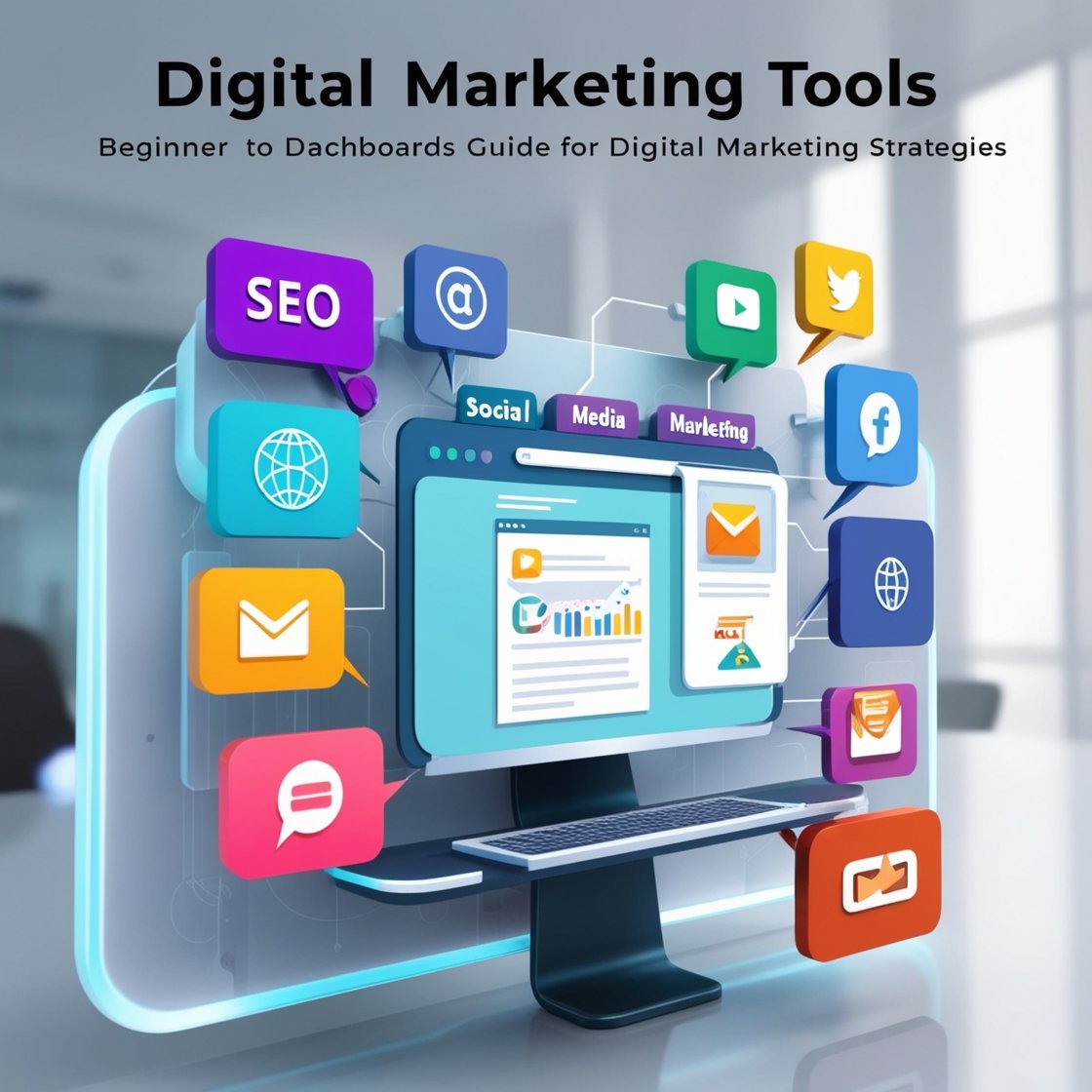Introduction
In a time when technology is the primary means of communication, businesses must adapt to digital settings to effectively engage their audience. Digital marketing is how companies advertise their goods and services via online channels such as websites, email campaigns, social media, and search engines. As a beginner, understanding the core elements of digital marketing is crucial to building a successful online presence. This guide is intended to assist you in getting started by giving you a basic overview of important digital marketing techniques, such as SEO, content marketing, social media, and email marketing.
1. Understanding Digital Marketing
Businesses use digital channels like search engines, social media, email, and websites to connect with current and potential customers. Unlike traditional marketing, digital marketing enables businesses to track and analyze data, which helps make more informed decisions and personalized customer experiences. “Digital marketing” is broad and covers all online marketing efforts.
The Importance of Digital Marketing
Cost-Effectiveness: Digital marketing campaigns are often more affordable than traditional print or TV ads.
Global Reach: The internet breaks down geographic barriers, enabling businesses to reach a global audience.
Measurable Results: Digital marketing tools provide instant feedback on campaign performance, such as click-through rates, conversions, and traffic.
Targeted Advertising: Platforms like Facebook and Google offer sophisticated targeting options, allowing businesses to focus on specific demographics, interests, and behaviors.
2. Core Components of Digital Marketing Strategies
To create a successful digital marketing plan, it’s essential to understand the main strategies that underpin digital marketing efforts:
2.1. Search Engine Optimization (SEO)
SEO is optimizing your website to rank higher in search engine results, increasing visibility, and driving traffic to your site. SEO is divided into two main categories:
On-Page SEO: Focuses on optimizing individual web pages to rank higher. This includes using relevant keywords, creating quality content, optimizing images, and ensuring a fast page load speed.
Off-Page SEO: Involves activities outside your website, like backlink building, social media engagement, and guest blogging. The more authoritative websites link back to your site, the higher your chances of ranking.
2.2. Content Marketing
Content is king in digital marketing. Content marketing involves creating and distributing valuable, relevant, consistent content to attract and engage a target audience. This content can take many forms, including:
Blog Posts: These provide an excellent way to improve SEO and offer helpful information to your audience.
Videos: YouTube and social media platforms like Instagram or TikTok are great for reaching audiences with dynamic visual content.
Infographics: These visually appealing formats are highly shareable and can simplify complex information.
Ebooks and Whitepapers: Offering in-depth content in exchange for email addresses helps build your lead generation list.
The key to content marketing is delivering value to your audience without explicitly selling. Content should solve problems, inform, or entertain.
2.3. Social Media Marketing
Social media platforms are among the most effective tools for reaching audiences. Platforms such as Facebook, Instagram, LinkedIn, Twitter, and TikTok provide businesses with opportunities to engage with their target audience, promote content, and build a brand.
Paid Social Ads: Most social media platforms offer advertising options to target specific demographics.
Organic Posts: Consistently sharing quality content on your social media pages can grow your following and improve brand awareness.
Engagement: Replying to comments, participating in conversations, and running interactive posts (like polls or contests) foster a relationship with your audience.
Each platform serves different audiences, so it’s essential to select the right one for your business goals.
2.4. Email Marketing
Email marketing is one of the most direct ways to communicate with customers. It involves sending newsletters, promotional offers, or transactional messages to a list of subscribers.
Personalization: Segment your email lists based on user behavior, interests, and demographics to send more targeted and effective messages.
Automation: Use tools like MailChimp or HubSpot to send automated emails for welcoming new subscribers, following up on abandoned carts, or offering special promotions.
Metrics to Track: Open rates, click-through rates, and conversion rates help gauge the success of your email campaigns.
3. Building a Digital Marketing Plan
Creating a digital marketing strategy requires careful planning and execution. Here’s how you can get started:
3.1. Identify Your Goals
The first step in building your plan is identifying what you want to achieve. Common digital marketing goals include:
Increase Website Traffic: By leveraging SEO and content marketing, you can drive more visitors to your website.
Generate Leads: Use lead magnets like free ebooks or webinars in exchange for users’ contact information.
Boost Sales: Use retargeting ads or email campaigns to encourage people to complete purchases.
Build Brand Awareness: Social media and content marketing can increase visibility and create a positive association with your brand.
3.2. Know Your Audience
Understanding your audience is crucial for any digital marketing strategy. Conduct market research to define your target demographic, preferences, behaviors, and pain points. Creating customer personas can help tailor your content and campaigns more effectively.
3.3. Choose the Right Channels
Not all digital marketing channels are suitable for every business. Select the channels that align best with your audience and goals. For example:
SEO and Content Marketing: Ideal for businesses looking to grow organic traffic and establish authority.
Social Media: Effective for building brand awareness and community engagement.
Email Marketing: Best for maintaining customer relationships and promoting special offers.
3.4. Create a Budget
Determine how much you are willing to spend on your campaigns. This includes costs for advertising, content creation, tools (e.g., email marketing platforms), and potentially outsourcing certain tasks like SEO optimization or paid ads management.
3.5. Measure and Analyze Results
Use analytics tools (like Google Analytics, Facebook Insights, or email marketing platforms) to track the success of your campaigns. Review key metrics such as traffic, conversions, engagement rates, and ROI to see what works and needs improvement.
4. Best Practices for Digital Marketing Success
As you implement your digital marketing strategies, keep the following best practices in mind:
Consistency is Key: Whether you’re posting on social media or sending out email newsletters, consistency helps build trust and keeps your audience engaged.
Focus on Quality: High-quality content that provides value will always perform better than low-effort, generic content.
Adapt to Trends: Digital marketing trends change quickly. Keep an eye on emerging platforms, new algorithms, and shifts in consumer behavior.
Test and Optimize*: Regularly conduct A/B testing on your campaigns to identify what works best. This will help you make informed decisions and improve your marketing efforts.
Conclusion
Digital marketing offers a powerful way to connect with your audience and achieve your business goals. By mastering SEO, content marketing, social media marketing, and email campaigns, you can build a comprehensive digital marketing strategy that drives results. Whether you’re looking to increase traffic, generate leads, or boost brand awareness, this guide provides a solid foundation for getting started with digital marketing strategies. Remember, the digital landscape is dynamic, so continuous learning and adaptation are essential for long-term success.





